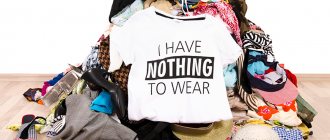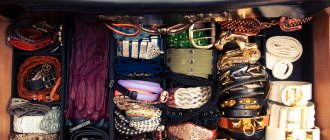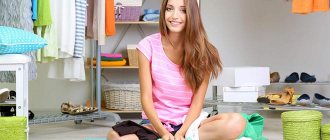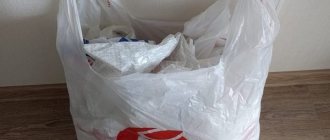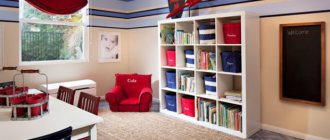Hi all! Undoubtedly, in every family the child has the most things, so putting the children's closet in order becomes an urgent problem for the mother. Kids grow so quickly that sometimes you simply don’t have time to buy new clothes and remove pants and T-shirts that have become too small from the shelves. I cleaned up my children's closet quite a long time ago, more precisely, immediately after the birth of my eldest daughter. By that time, I had already mastered the basic principles of maintaining cleanliness and order in the house and applied them in practice. So I can assure you: if you have no idea where to start and how to rationally organize the storage of children's things, you are not in vain reading this article. I will give you a detailed action plan based on my personal experience.
In general, the principles of storing children's and adult things are similar, but there are several nuances. It is important to take into account the child’s small stature, his inability to fold clothes neatly (although this depends on age) and other features. By the way, my eldest daughter is 4 years old, and watching me roll up socks and fold T-shirts, she always actively helps. Moreover, she has already started to do well.
So where to start?
Walls as storage space
If you don't like shelving or don't have room for classic cabinets, then there's only one word you need to know - pegboard. Fashionable, cheap, practical, unusual, in a word, all the advantages!
A pegboard is a perforated panel for wall storage of various items. The holes are intended for fastening hanging elements, shelves, baskets, hooks, etc. Next time you are in a mass market store, take a closer look, they use the same principle. You can move the shelves whenever it is convenient and do it for different tasks. By and large, you can even hang a child’s bicycle on such a wall so that the wheels don’t stain the floor.
In the hallway you can hang jackets, caps, hats, and belts on a pegboard. In the nursery, this will become a space for imagination: hang the shelves in a chaotic manner and experiment with books, games, and stationery. After all, the pegboard does not have to be on the entire wall, it can be a mini pegboard for creative supplies (hang scissors, tape, shelves for boxes with stickers and felt-tip pens - the child knows best, let him design it himself).
Lifehacks for folding children's things
As much as we love the Konmari method, we understand that people may prefer a different technique. Also, what about items that are just weird to put together?
- Shirt/T-shirt: Another effective way to fold baby clothes is the folding method. For shirts and T-shirts, simply fold in the sleeves and roll the garment into a cylinder.
- Pants: To roll up your pants, fold them in half and tuck them into the crotch. Once you've done this, roll the pant legs into a cylinder.
- Bibs: Baby bibs can be awkward to fold. Some people stack them on top of each other. However, you can roll them up by folding the neck strap down and then roll them up to finish.
- Hanging Bag for Bulky Items: To save space in your closet, you can purchase hanger bags for bulky items like coats and overalls. They will compress the fabric down and make them more efficient for storage.
- Use over-the-door storage : Over-the-door storage works well for storing items like socks, mittens, and hats. Use this for any item that is weird to fold.
- Divider Hangers: To find items more easily in your child's closet, consider purchasing a divider hanger. You can separate items by size, season, or clothing type for easier organization.
Let's be honest: before we looked at KonMari's compact folding method for baby clothes, we were absolutely terrified of folding clothes. However, now it is the only job we look forward to every week.
This may seem scary at first, but once you take the time to try this method it won't be so scary. Even if you choose a different folding method, washing shouldn't be difficult. The key is finding the right technique to suit your style.
Use delimiters
Use the main feature of children's clothing: it is small. And the shelves of the closets are made as standard for adult clothes. Use dividers and you will double the storage capacity of your closet! We show clearly what shelf dividers are.
On AliExpress, such things cost pennies, but your nerves are priceless.
Will never come in handy
We know and understand everything: you carefully selected every item without exception, you may have ordered something even from overseas, and this crimson bodysuit with sheep - yes, you went to the other end of town for it! But, alas, if you want to become a master of storing things in a children's room, then you need to pass the decluttering exam with a solid A - namely:
- get rid of all the clothes the child has outgrown,
- give away all the toys he no longer plays with,
- throw away everything that “we’ll fix someday”
- get rid of devices that are no longer useful.
And not an obvious point: remember that you are in a nursery and just think: if a thing doesn’t make you happy, then... Maybe it’s not needed at all? After all, what you once dreamed about, wanted, liked, may simply cease to bring pleasure. A great idea is to give it to someone to whom it will truly bring sincere joy.
Beds as storage space
www.ikea.com
A functional bed is a trend not only for children. New York style, replacing the Scandinavian coziness, will become close to everyone who is limited in space. This is where beds with built-in storage drawers come in handy. We are used to the fact that we can put our laundry there, but now we can order a functional bed with drawers of different sizes and store clothes, shoes, personal items, art supplies and, of course, toys there.
www.pinterest.com
Logic is the key to convenience and practicality
Adjust storage systems to suit your child's needs. What you need every day should be in sight. If your child is a young artist, put a box of pencils and albums on the table, and put plasticine and other supplies in the box: you can take them out as needed. If your child wears sports clothes more often, let them be stored on the shelf that is most convenient for his height - the one at arm level. If you often read books, place them all on the lower floors and place them vertically: you will find and get the book you need in no time.
How to put children's things in a chest of drawers using the Konmari method?
For each type of clothing, there is a special way to fold it for storage using the filing method. Each piece of clothing has its own unique fold.
There are a few general rules when folding clothes using the KonMari method:
- Make sure you have a clean, flat surface to hand: this will make folding much easier as you will have room to fold and can do it correctly.
- Smooth out your clothes as you fold them: this will prevent you from having a bulky final product. This can also help with creases.
- The final product should be able to stand on its own: you'll find that clothes folded using the KonMari method fold into three sections for this very reason. Since it is stored vertically, you need to make sure it sits straight in the drawer.
- Leave 2.5 or 5cm of space at the top: this will also help ensure the product stands on its own.
- Organization is key: The point of folding is to have a more organized drawer. Marie Kondo recommends purchasing drawer dividers or small boxes to store items like socks and underwear. This will keep them from getting mixed up together or, worse, getting lost.
Folding baby bodysuits and T-shirts
To fold your bodysuit, start by laying it flat. The next thing you want to do is fold the bodysuit inward, lengthwise, on each side, and tuck in the sleeves. Take your hands and smooth down the bodysuit again to smooth out any lumps or wrinkles.
You will then fold the bodysuit in three stages, starting from the bottom. Make sure the folds are straight and clean. This will allow you to place the bodysuit straight in the drawer and it will take up minimal space.
Folding children's shirts
When you fold a shirt, you should start folding one side of the shirt. Take your shirt sleeve and fold it back onto the folded panel you just made. Then you will repeat on the other side.
Be sure to iron the shirt to remove any wrinkles and then fold it in half, but leave a small gap at the end. Finally, you will fold the shirt into thirds and then it will be ready to be put away.
Hooded sweatshirts can be folded in the same way. The only extra step is to fold the hood after you fold the sleeves.
Folding children's trousers
To fold pants using the KonMari method, simply lay the pants on a flat surface and then fold one pant leg on top of the other. Make sure the crotch is tucked in and fold the pants almost in half, leaving some room at the top.
Once you've done this, fold your pants into thirds from the bottom up to give them the size they need to stand up straight.
Folding children's pajamas
Pajamas seem daunting to fold, but they really aren't. To fold them, you simply lay them flat and start folding the sleeves. You will then lift the two pant legs up until they are almost folded in half.
Once you have done this, fold it in half and then it will be ready to be placed in the box.
Folding baby socks
While many people fold socks by stacking one on top of the other, there is a much more efficient way to do it. Stacking your socks on top of each other can sprain your ankle and ruin the fit. To fold socks the Konmari way, simply place one sock on top of the other.
Once you do this, simply fold them in half. Then place them in a divider box that can fit right into your child's sock drawer.
Folding underwear
If you're currently potty training you might be wondering how to fold those tiny pairs of underwear. Folding underwear is easy with KonMari.
Start by laying your underwear on a flat surface. Then you'll fold the bottom up so it forms a long, skinny rectangle. Once you've done this, fold them in half twice so they make a small square. That's all there is to it.
What to buy - a wardrobe or a chest of drawers?
Buying a children's wardrobe or chest of drawers for your room is a must. The child must know where his things are stored and how to store them correctly. The advantage of the chest of drawers is obvious:
- you can fold a large number of things;
- Several drawers allow you to conveniently sort clothes;
- a chest of drawers saves space in the room;
- It is easier for a child to use a chest of drawers than a closet.
Children's wardrobes can be combined with a chest of drawers, where you can compactly fold and place all your children's things.
